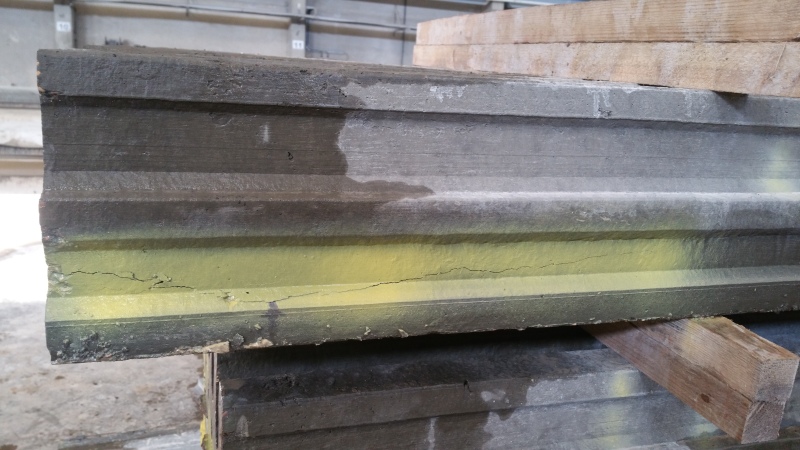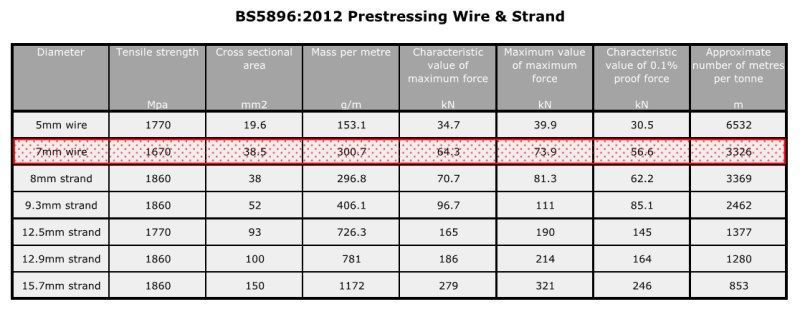Navigation
Install the app
How to install the app on iOS
Follow along with the video below to see how to install our site as a web app on your home screen.
Note: This feature may not be available in some browsers.
More options
Style variation
-
Congratulations MintJulep on being selected by the Eng-Tips community for having the most helpful posts in the forums last week. Way to Go!
You are using an out of date browser. It may not display this or other websites correctly.
You should upgrade or use an alternative browser.
You should upgrade or use an alternative browser.
Prestressed Ground Beams
- Thread starter amaidj
- Start date
- Status
- Not open for further replies.
Did the cracks appear immediately after release/transfer of the prestress from the bed to the concrete section?
Do you mean 5 each x 7-wire strands or is it 5 each x 7mm dia plain (unstranded) wires?
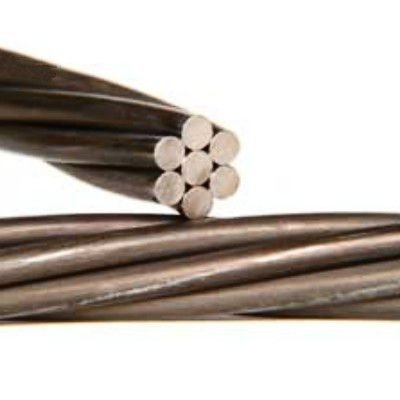
I would expect the majority of prestress to be in the bottom flange, maybe some prestress in the top - where is your prestress placed in the section?
amaidj said:i used 5-7dia prestressed wires
Do you mean 5 each x 7-wire strands or is it 5 each x 7mm dia plain (unstranded) wires?

I would expect the majority of prestress to be in the bottom flange, maybe some prestress in the top - where is your prestress placed in the section?
TehMightyEngineer
Structural
Any transverse reinforcement?
Professional Engineer (ME, NH, MA) Structural Engineer (IL)
American Concrete Industries
Professional Engineer (ME, NH, MA) Structural Engineer (IL)
American Concrete Industries
- Thread starter
- #4
@Ingenuity, its 7mm dia wire of area 38.5mm2
i have 3 wires at 27mm from bottom then one at 50 mm at bottom and them one at 75mm from bottom
these are ground beams use for flooring.
the section depth is 225mm
i think as per my understanding the stress applied is too much for this small secrion which is why it happened at ends and yes it happens at transfer.
@Tehmightyengineer, there is no reinforcement in it other then prestressing wires becuase they are ground beams something like for flooring system and they are so small that no any other reinforcement can be used in there.
i have 3 wires at 27mm from bottom then one at 50 mm at bottom and them one at 75mm from bottom
these are ground beams use for flooring.
the section depth is 225mm
i think as per my understanding the stress applied is too much for this small secrion which is why it happened at ends and yes it happens at transfer.
@Tehmightyengineer, there is no reinforcement in it other then prestressing wires becuase they are ground beams something like for flooring system and they are so small that no any other reinforcement can be used in there.
TehMightyEngineer
Structural
Break the bond in some of the prestressing wires at the end to stagger the location where they transfer the prestressing force to the ground beams. Alternatively, provide transverse reinforcement hoops or a wire cage in the ends to resist this bursting stress. Or increase your transfer compressive strength of the concrete.
Professional Engineer (ME, NH, MA) Structural Engineer (IL)
American Concrete Industries
Professional Engineer (ME, NH, MA) Structural Engineer (IL)
American Concrete Industries
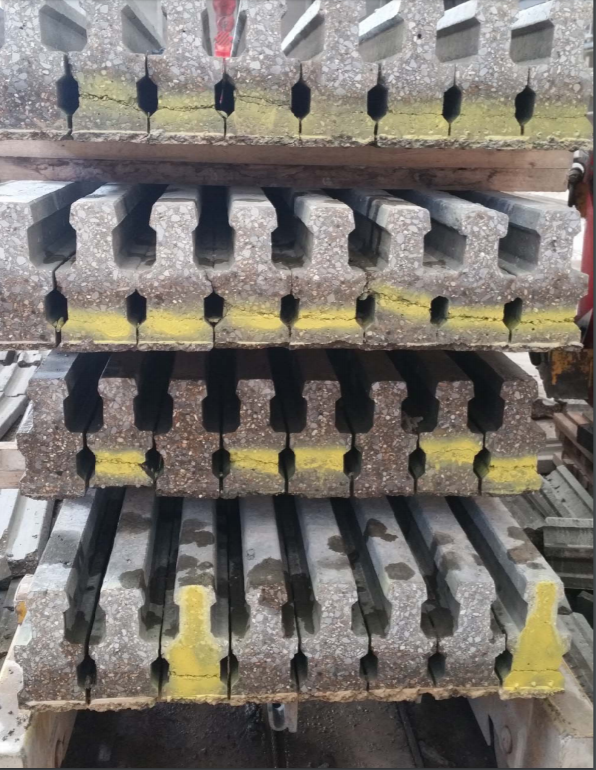
Based upon the 32 beams in the above photo, 21 of them (or 2/3 rds) have horizontal cracking. Not good.
Looks like the product is produced in a long-line bed, using an extrusion process (similar to hollow-core), then cut up into required lengths.
TME's idea of debonding wires or adding transverse rebar may be a major hiccup in your manufacturing productivity - but producing product with such a high rate of cracking is not cost effective either
Making a few assumptions and approx calcs:
Assume Peff is 65% of Pu, so for 5 wires your Peff is about 225 kN. Eccentricity of prestress is 41.2mm from bottom (57.7mm from CG).
Assuming an equivalent rectangular section of 225mm deep x 85mm wide your Ig is about 80x106mm4, Ag is about 19,200 mm2
P/Ag is 11.7 MPa!!!
Plug and chug into your classic elastic stress formulae ==> your bottom fiber COMPRESSIVE stress at ends of the member is "theoretically" 28 MPa, and top fiber TENSION stress is more than 9 MPa.
So unless your fci (concrete compressive strength at transfer) is about 40 MPa, you exceed most code-prescribed compression limits of 0.70f'ci (and tensile limits of 0.5√f'ci).
Are you steam curing overnight to accelerate your curing and strength gain, and do you bust a cylinder to verify concrete strength PRIOR to transfer?
- Thread starter
- #9
amaidj said:do you mean my fci suppose to be 40Mpa at transfer?
Probably somewhere close to 40 MPa. Depends on the magnitude of your prestress force at transfer. What is the jacking force of each wire - stressing to 70% of fpu?
What is your typical concrete compressive strength at transfer?
- Thread starter
- #11
Ingenuity,
.7fci at transfer is very high. I would normally limit to about .5 as transfer.
Remember this is going to be the stress condition at the ends (less loss effects) for eternity (or until they smash themselves) so long term compression needs to be considered as well as there will be no other loading effects at the ends.
Service stress conditions after losses also need to be checked and limited to about .4 - .45 Fc.
.7fci at transfer is very high. I would normally limit to about .5 as transfer.
Remember this is going to be the stress condition at the ends (less loss effects) for eternity (or until they smash themselves) so long term compression needs to be considered as well as there will be no other loading effects at the ends.
Service stress conditions after losses also need to be checked and limited to about .4 - .45 Fc.
rapt said:.7fci at transfer is very high. I would normally limit to about .5 as transfer.
rapt:
I should have stated "the world's leading code on prestressed concrete" rather than "most code-prescribed compression limits"
Back in 2008, I think, ACI 318 upped the transfer/release compression stress limits from 0.6 to 0.7 to the ends of members.
A PCI paper by Dolan and Krohn:
"A CASE FOR INCREASING THE ALLOWABLE COMPRESSIVE RELEASE STRENGTH FOR PRESTRESSED CONCRETE"
Paper is attached, or link here: [link
]Link[/url]
Interesting that the OP is using prestressing wire - it must be a UK thing - as in the US and AU wire is never used today. Small diameter 7-wire strand is used by some precasters in the US and AU.
For example Ultrafloors in AU make similar 'bearers' to the OP using 3 x 9.5mm dia 7-wire strand with a f'c of 65 MPa.
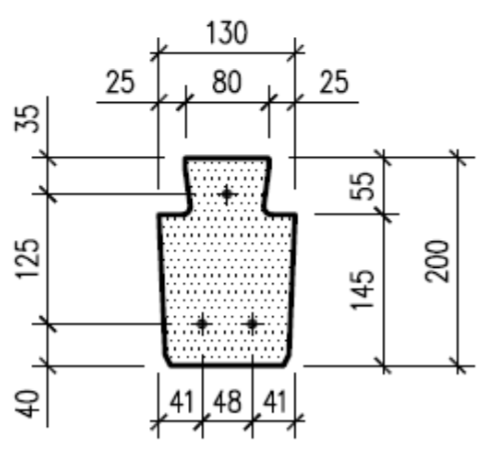
amaidj said:i have just figured out my sections are overstressed
I think your "concrete" was telling you that
Ingenuity,
I cannot comment on your first sentence or I might get tweeted upon!
But the writers of "the world's leading code on prestressed concrete" need to have a rethink about this clause, as well as a lot of others we have discussed previously. Maybe getting a "PT expert" on the committee who actually knows what he is talking about would help!
I know of one project in Australia where the stresses are at .6, and they have severe delamination problems in several members.
And one member where they had to add a post grouted joint at mid-span and the resulting stress was closer to .7, they snapped it upwards resulting in an upward "deflection" of about 800mm (they refuse to post signs on the structure warning of the potential problems, but at least I know where it is so can avoid driving under it).
Part of the problem with pre-tensioned members is that the stress at the end is basically the permanent stress (less creep losses in the prestress). And that really needs to be limited to about .4-.45 to avoid non-linear creep effects.
I cannot believe that someone has "designed" and constructed these elements without doing the calculations. Probably about 10 minutes work for a reasonably accurate guess as you showed above.
I cannot comment on your first sentence or I might get tweeted upon!
But the writers of "the world's leading code on prestressed concrete" need to have a rethink about this clause, as well as a lot of others we have discussed previously. Maybe getting a "PT expert" on the committee who actually knows what he is talking about would help!
I know of one project in Australia where the stresses are at .6, and they have severe delamination problems in several members.
And one member where they had to add a post grouted joint at mid-span and the resulting stress was closer to .7, they snapped it upwards resulting in an upward "deflection" of about 800mm (they refuse to post signs on the structure warning of the potential problems, but at least I know where it is so can avoid driving under it).
Part of the problem with pre-tensioned members is that the stress at the end is basically the permanent stress (less creep losses in the prestress). And that really needs to be limited to about .4-.45 to avoid non-linear creep effects.
I cannot believe that someone has "designed" and constructed these elements without doing the calculations. Probably about 10 minutes work for a reasonably accurate guess as you showed above.
Also, using wire should have helped him in this case as the development length is about double, so it effectively gave a longer de-bonded length.
Only problem is there is effectively no capacity for anything near the end of the beam as it is essentially unreinforced!
Only problem is there is effectively no capacity for anything near the end of the beam as it is essentially unreinforced!
rapt said:Also, using wire should have helped him in this case as the development length is about double, so it effectively gave a longer de-bonded length.
About 100db, so about 700mm for 7mm ø wire.
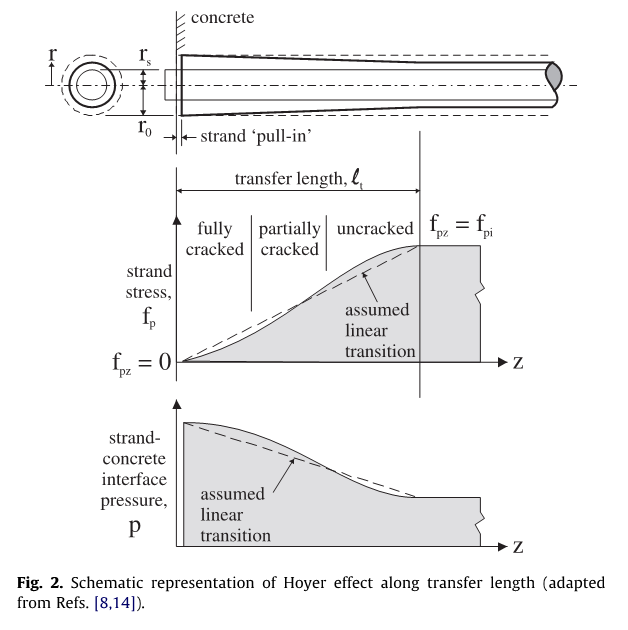
If you look at the Hoyer effect (radial dilation of wire due to Poisson effect) the "cracking length" in the OP's beam is about 450mm or about 2/3rds of the transfer length of 700mm. The location of the crack appears to correspond to the 2nd row of prestressing wire - 50mm from bottom.
rapt said:Only problem is there is effectively no capacity for anything near the end of the beam as it is essentially unreinforced!
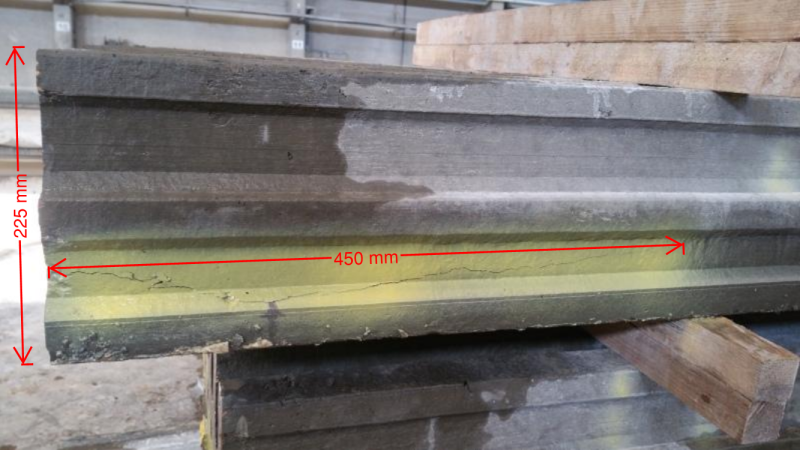
If the OP has access to some know-mass concrete blocks, it would be good to test the above beam to failure in 4-point bending, assuming it can support its self-weight!
Ingenuity,
It can be worse.
AS3600 says 175db (1225) if Fc < 32MPa. And the first 10% of the transmission length has zero force!
But that is only the transmission length and it is for crimped or indented wire. If it is plain wire, who knows.
Then you have to add the development length to get to the point where the strand can develop full strength. That is a total of 2.25 times the transmission length, so about 2.8m for 7mm wire! So if the concrete beam is less than 5.6m long, the wire can never develop full strength.
And in the 900mm from the end, it will be under 50% of the ultimate strength of the wire reducing to 0 at 122.5mm from the end of the beam. At the 1st critical shear section, there will only be about 5% of the steel capacity available. But as the prestress wires are reducing in capacity towards the support, their available stress reduces, so their contribution to shear capacity reduces. So you cannot check shear at d from the support, you need to check it at the support, and at that point, the steel is unbonded and cannot develop any capacity. So at your worst shear point, you have no shear capacity!
I still wonder how pretension member designers can justify the lack of development of their members at the ends!
It can be worse.
AS3600 says 175db (1225) if Fc < 32MPa. And the first 10% of the transmission length has zero force!
But that is only the transmission length and it is for crimped or indented wire. If it is plain wire, who knows.
Then you have to add the development length to get to the point where the strand can develop full strength. That is a total of 2.25 times the transmission length, so about 2.8m for 7mm wire! So if the concrete beam is less than 5.6m long, the wire can never develop full strength.
And in the 900mm from the end, it will be under 50% of the ultimate strength of the wire reducing to 0 at 122.5mm from the end of the beam. At the 1st critical shear section, there will only be about 5% of the steel capacity available. But as the prestress wires are reducing in capacity towards the support, their available stress reduces, so their contribution to shear capacity reduces. So you cannot check shear at d from the support, you need to check it at the support, and at that point, the steel is unbonded and cannot develop any capacity. So at your worst shear point, you have no shear capacity!
I still wonder how pretension member designers can justify the lack of development of their members at the ends!
- Status
- Not open for further replies.
Similar threads
- Question
- Replies
- 0
- Views
- 1K
- Locked
- Question
- Replies
- 4
- Views
- 3K
- Replies
- 2
- Views
- 7K
- Locked
- Question
- Replies
- 1
- Views
- 1K
- Replies
- 3
- Views
- 3K

